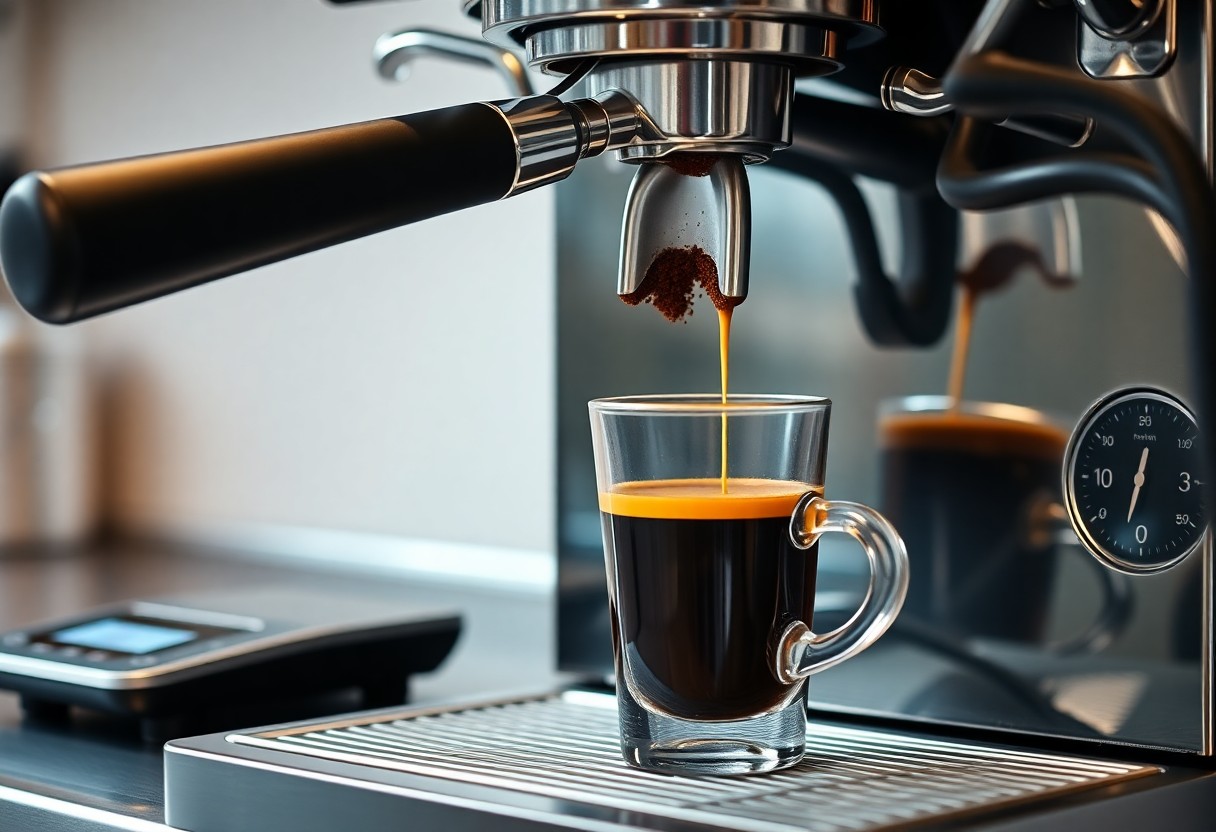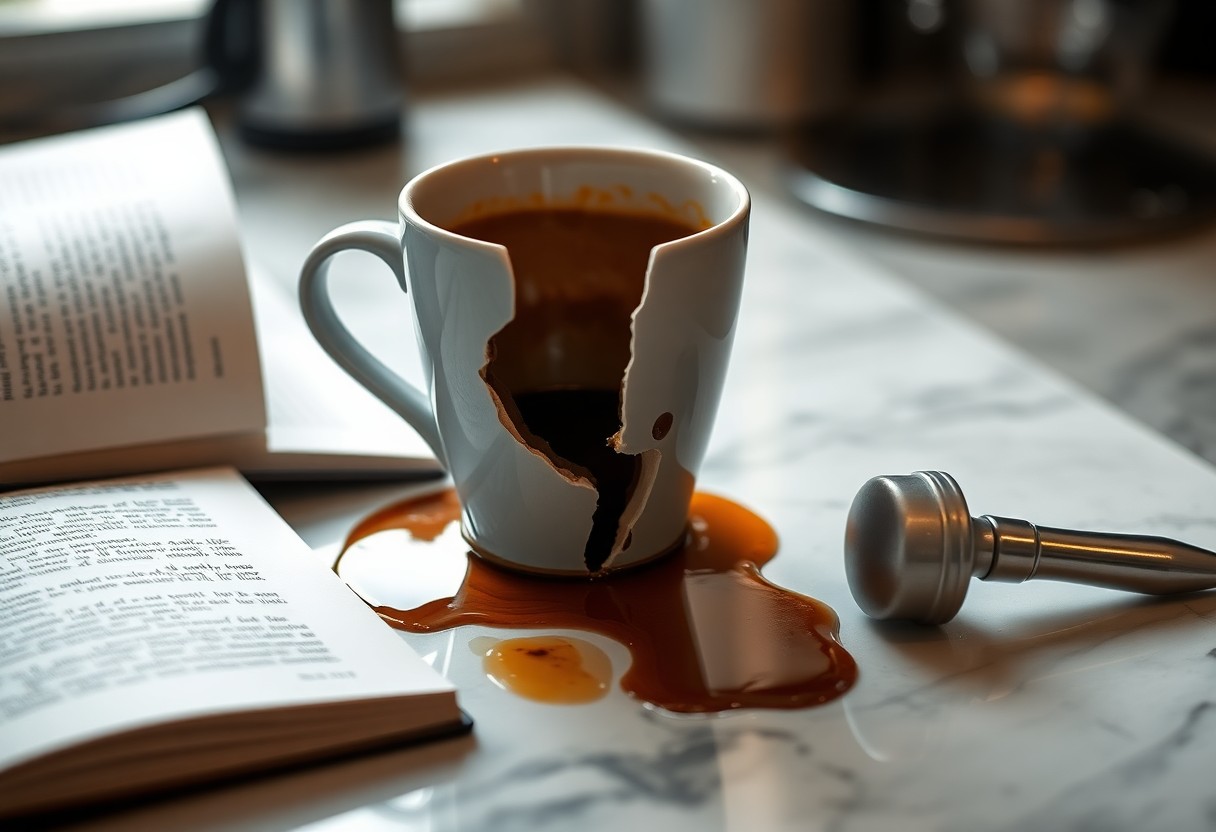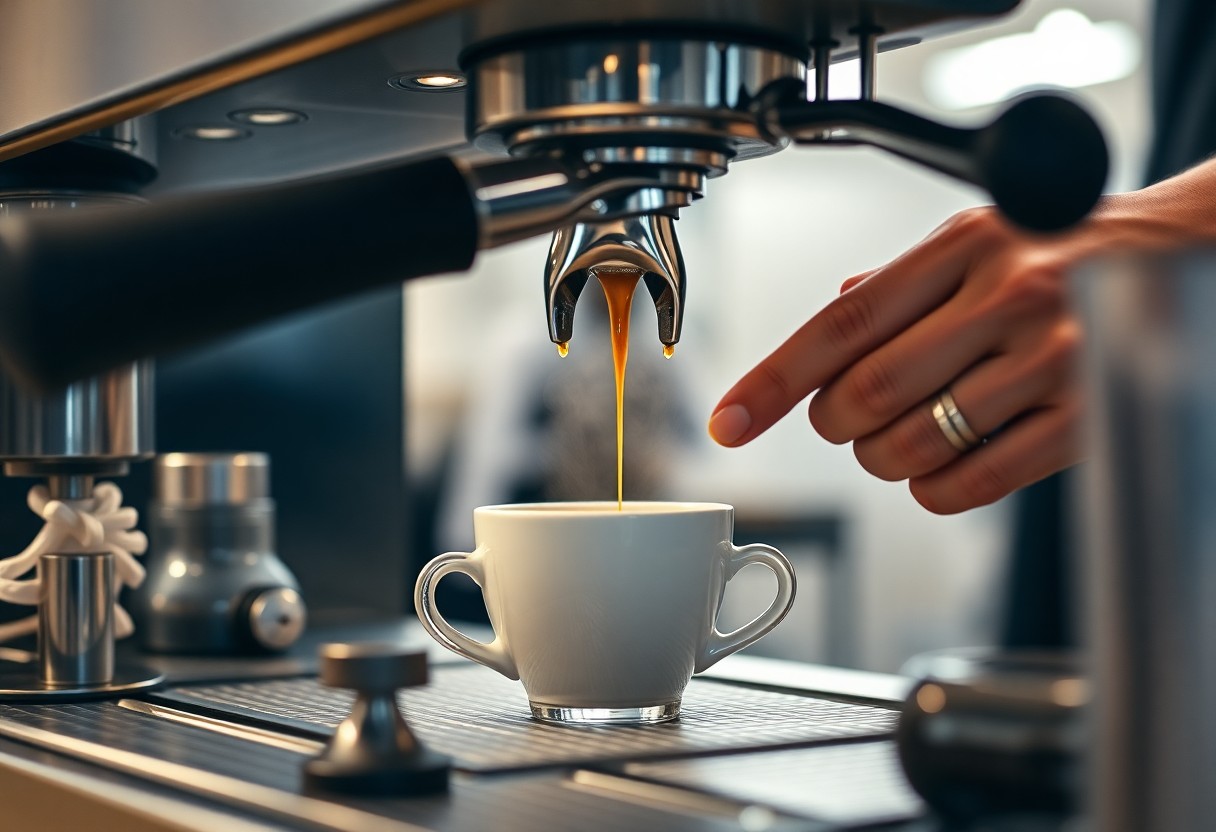Just when you think your espresso shot is ruined, you can still salvage it with a few simple adjustments. Understanding how to execute an Espresso Reset can transform a lackluster brew into a surprisingly delightful cup without the need to start the process from scratch. By tweaking factors like grind size, tamp pressure, and extraction time, you can effectively fix a subpar shot and enhance the flavors, allowing you to savor the vibrant characteristics of your coffee beans. With these techniques, you’ll elevate your espresso game and reduce waste, making every cup count.
Key Takeaways:
- Understanding how to adjust grind size and extraction time can significantly improve shot quality.
- Pay attention to brewing temperature, as it can impact flavor and overall result when correcting a shot.
- Experimentation with different variables, such as dose and tamping technique, can lead to a consistently better espresso experience.
Recognizing the Signs of a Bad Shot
Identifying a poor espresso shot early on can save you time and coffee beans. Initial signs often manifest visually; if your shot lacks a rich crema or appears watery, it’s a clear indicator of extraction issues. Additionally, aromas matter; an unpleasant, burnt smell or sour notes can suggest under or over-extraction. When tasting, you may encounter flavors that are overly bitter or lacking balance, signaling that adjustments are needed before you hit the brew button again.
Common Characteristics of Poor Espresso
Typical red flags of a bad espresso shot include a thin crema, uneven color, and a weak body. A thin crema denotes insufficient pressure during extraction, while a pale or greyish hue suggests that the coffee hasn’t been fully extracted. Weak body often results in flavors that don’t pop, leaving you with a flat and unappealing cup. These characteristics can significantly detract from the overall quality and enjoyment of your espresso.
Analyzing Extraction Failures
To diagnose extraction failures, focus on variables like grind size, water temperature, and timing. If the grind is too coarse, water flows through too quickly, leading to under-extraction. Conversely, a fine grind can clog the basket, causing over-extraction and bitterness. Ideal water temperature for brewing espresso ranges from 195°F to 205°F; temperatures outside this range can adversely affect flavor extraction. Additionally, timing is imperative; ideal extraction typically takes 25 to 30 seconds. Any deviations here can contribute to an undesirable shot.
Taking time to analyze these parameters can significantly improve your espresso-making skills. For example, if you notice that your shots are consistently bitter and take longer than 30 seconds, consider adjusting your grind finer while ensuring your machine maintains the correct temperature. A shot that extracts within the desired time frame not only enhances flavor but also allows you to identify any further issues that may arise. Conduct periodic taste tests to fine-tune your approach, ensuring you get that perfect shot every time.

The Science of Espresso Extraction: What Went Wrong
Espresso extraction is a delicate balance of multiple factors, and a malfunction in any part can lead to subpar results. A bad shot may stem from uneven grind size, incorrect water temperature, or improper tamping pressure. Each of these elements plays a vital role; for example, under-extraction often produces sourness due to insufficient flavor compounds, while over-extraction leads to bitterness as too many soluble solids are extracted. By understanding what went awry, you can troubleshoot to reset your espresso shot effectively.
Variables Affecting Flavor Profiles
A variety of variables influence the flavor profiles of your espresso. These include grind size, dose weight, water temperature, and brew time. Each change in these parameters can elicit vastly different tastes in your shot. For instance, a finer grind size typically intensifies extraction and enhances sweetness, while a coarser grind might lead to a more acidic and brighter flavor. Aiming for the right balance of these variables ensures a well-rounded cup.
Unpacking Consistency and Balance
Achieving consistency and balance in espresso preparation means replicating the ideal conditions every time you brew. Many baristas develop a routine to measure parameters like coffee weight, water temperature, and timing, which fosters repeatable results. A common benchmark for espresso is a brew ratio of 1:2; for instance, using 18 grams of coffee to produce 36 grams of espresso in roughly 25 to 30 seconds often yields a nice balance. This approach leads to a more harmonious flavor profile, avoiding excessive bitterness or acidity in your shot.
Your espresso journey hinges on precision and attention to detail. By establishing a defined process—consistently measuring coffee and water, fine-tuning grind size, and adhering to time standards—you create a foundation for exceptional espresso. For example, experimenting with a specific grind size and maintaining a consistent tamp pressure not only enhances extraction but fosters the ability to predict the resulting flavor profile accurately. This predictability allows you to make informed adjustments, ensuring each shot contributes to a well-balanced espresso experience.
Quick Fixes for Immediate Flavor Improvement
Improving your espresso shot doesn’t have to start from scratch. Quick fixes can enhance the flavors dramatically without requiring a full reset of your equipment or coffee. By making small adjustments, you can often salvage an unsatisfactory brew and bring out the rich characteristics of your beans. The following techniques focus on two primary areas: grind size and brew temperature, both of which can have a significant impact on the final beverage.
Adjusting Grind Size and Distribution
Changing the grind size can lead to noticeable shifts in extraction and flavor. Finer grounds pack more tightly, increasing resistance and brewing time, while coarser grinds allow water to flow more freely but might under-extract. Adjusting the grind by even a single increment can help you achieve the perfect balance for your specific coffee and machine setup.
Tweaking Brew Temperature and Time
Fine-tuning the brew temperature and extraction time are effective ways to enhance your espresso’s flavor profile. A higher brew temperature may extract more oils and acids, resulting in a brighter, bolder flavor, while lowering the temperature can highlight sweetness and softness. Experimenting with brewing time can also make a difference; shorter times may yield a clean flavor, whereas longer times may develop richness and body.
Adjusting Brew Temperature
| Temperature Adjustment | Flavor Impact |
|---|---|
| Higher Temperature (200-205°F) | Brighter, more acidic profile with heightened flavor complexity. |
| Lower Temperature (190-195°F) | Sweeter, softer, less acidic espresso that focuses on balance. |
Tweaking Brew Time
| Extraction Time Adjustment | Flavor Impact |
|---|---|
| Less than 25 seconds | Under-extracted, sour flavors with little body. |
| More than 30 seconds | Over-extracted, bitter flavors with a heavy mouthfeel. |
Experimentation is key when adjusting brew temperature and time. A small tweak in temperature can lead to profound changes in flavor; for instance, if you find your shot bitter, lowering the temperature slightly can help achieve a sweeter outcome. Similarly, adjusting your extraction time requires attention to the specific coffee at hand. For many espresso enthusiasts, dialing in these aspects through practice can significantly elevate your brewing success and highlight the desired flavor notes from your beans.
Techniques for Rescuing Coffee While Maintaining Quality
First off, you have a few options to save that espresso without wasting your time or beans. Each technique has its pros and cons, depending on what went wrong with your shot. Whether you choose to re-pull the shot or revive the original one, getting that rich flavor and body back can be done with some thoughtful adjustments and creativity.
Re-pulling vs. Reviving the Original Shot
Deciding whether to re-pull your espresso shot or to revive the original is key. If the extraction was underdeveloped, simply re-pulling a shot with the same dose can yield better results by resolving channeling issues. On the other hand, if the shot is slightly bitter or too watery without having the right amount of crema, you might salvage your original shot with a touch of added sugar or milk instead.
Using Blends to Mask Imperfections
Blending your espresso can effectively hide any off-flavors that emerged from a bad shot. Combining your initial espresso with a different coffee, particularly a well-balanced one, can create a more palatable result. The right blend can harmonize flavors and bring out sweeter notes, reducing the unpleasant aspects of your failed shot.
By incorporating a blend, you can harness the strengths of different beans. For instance, if your original shot turned overly bitter, mixing it with a naturally sweet, fruity blend can balance out those harsh notes. A typical ratio might be 50% of your original shot with 50% of a high-quality, flavorful blend. This approach not only improves the final cup but also allows for experimentation, helping you discover new favorites along the way. Just ensure that your blends are complementary to the flavors you want to emphasize, turning potential waste into an opportunity for discovery.

Learning from Mistakes: Building Future Resilience
Each flawed espresso shot offers valuable lessons that enhance your skills over time. By analyzing what went wrong, you cultivate a greater understanding of your equipment and coffee variables. Learn to embrace these missteps; they become stepping stones on your journey to espresso mastery. Instead of feeling defeated by a bad shot, consider it a critical part of the learning process, helping you refine your technique and strengthen your resilience in coffee-making.
Documenting and Tracking Espresso Variables
Maintaining a detailed log of your espresso parameters fosters a deeper awareness of what affects flavor. Note variables like grind size, dose, extraction time, and water temperature with each shot. This documentation transforms your process into a valuable resource, enabling you to successfully repeat successes and avoid repeating mistakes. You’ll find that tracking even minor details can unveil significant insights into your brewing habits.
Establishing a Routine for Consistent Results
Creating a consistent routine is vital for achieving reliable results in your espresso practice. Start with a set order of operations for grinding, tamping, and brewing. Standardizing your processes ensures that you minimize variables, leading to better quality shots. Testing different methods can help you discover what works best for your equipment and beans while offering a predictable framework that fosters confidence in your brewing skills.
Continuing to refine your routine solidifies your espresso-making prowess. For instance, consider timing your extraction and aiming for a specific target within a narrow window, such as 25-30 seconds for a double shot. Integrate regular deep cleaning of your equipment to prevent buildup that affects flavor. Explore the effects of slight adjustments, like modifying your tamping pressure or the brew temperature, on the final cup. With practice, this routine develops into an intuitive system that adapts to your preferences, giving you consistency and satisfaction in every cup you brew.
Summing up
Following this, you can effectively enhance your espresso brewing skills by implementing the Espresso Reset technique. Rather than starting from scratch, adjust parameters like grind size, dose, and extraction time to salvage a less-than-perfect shot. This approach not only saves you time and coffee but also sharpens your understanding of espresso mechanics, empowering you to produce consistently flavorful results. Embrace this method to elevate your brewing practice and enjoy your espresso even more.
FAQ
Q: What does “The Espresso Reset” refer to?
A: “The Espresso Reset” is a technique used to adjust a poorly extracted espresso shot without having to start the brewing process from scratch. It involves making specific adjustments to variables such as grind size, tamp pressure, or brew time in response to the initial shot’s characteristics, allowing you to salvage the experience and improve the final outcome.
Q: When should I consider using the Espresso Reset technique?
A: You should consider using the Espresso Reset technique when you notice that your espresso shot has obvious issues, such as being overly bitter, under-extracted, or having a thin crema. If the shot isn’t meeting your taste expectations, this method can help you modify various brewing parameters to achieve a better flavor profile without wasting coffee or time.
Q: What are some common indicators that suggest a bad shot has been brewed?
A: Common indicators of a poorly brewed espresso shot include a very fast or slow extraction time, overly bitter or sour flavors, an absence of crema, or a watery texture. Additionally, a non-uniform color in the espresso, whether too light or dark, can signal that adjustments are needed before pulling another shot.
Q: What adjustments can I make when performing an Espresso Reset?
A: To perform an Espresso Reset, you can adjust several variables such as the grind size (making it finer for slower extraction or coarser for faster extraction), modifying the tamp pressure (pressing harder or softer), or changing the brew time by altering the length of the shot. Additionally, using fresher coffee beans or cleaning your equipment can contribute to better results.
Q: Is the Espresso Reset applicable to all coffee machines?
A: While the Espresso Reset technique can be applied to most espresso machines, the effectiveness may vary depending on the specific machine and its capabilities. Manual espresso machines typically offer more control over brewing parameters, while automatic machines may limit adjustments. Understanding your machine’s features will help determine how successfully you can implement this technique.
